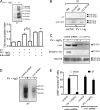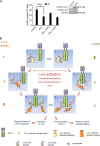Cross talk between receptor guanylyl cyclase C and c-src tyrosine kinase regulates colon cancer cell cytostasis
- PMID: 19620276
- PMCID: PMC2747985
- DOI: 10.1128/MCB.00001-09
Cross talk between receptor guanylyl cyclase C and c-src tyrosine kinase regulates colon cancer cell cytostasis
Abstract
Increased activation of c-src seen in colorectal cancer is an indicator of a poor clinical prognosis, suggesting that identification of downstream effectors of c-src may lead to new avenues of therapy. Guanylyl cyclase C (GC-C) is a receptor for the gastrointestinal hormones guanylin and uroguanylin and the bacterial heat-stable enterotoxin. Though activation of GC-C by its ligands elevates intracellular cyclic GMP (cGMP) levels and inhibits cell proliferation, its persistent expression in colorectal carcinomas and occult metastases makes it a marker for malignancy. We show here that GC-C is a substrate for inhibitory phosphorylation by c-src, resulting in reduced ligand-mediated cGMP production. Consequently, active c-src in colonic cells can overcome GC-C-mediated control of the cell cycle. Furthermore, docking of the c-src SH2 domain to phosphorylated GC-C results in colocalization and further activation of c-src. We therefore propose a novel feed-forward mechanism of activation of c-src that is induced by cross talk between a receptor GC and a tyrosine kinase. Our findings have important implications in understanding the molecular mechanisms involved in the progression and treatment of colorectal cancer.
Figures






Similar articles
-
Functional inactivation of the human guanylyl cyclase C receptor: modeling and mutation of the protein kinase-like domain.Biochemistry. 2001 Aug 7;40(31):9196-206. doi: 10.1021/bi002595g. Biochemistry. 2001. PMID: 11478887
-
Interaction of guanylyl cyclase C with SH3 domain of Src tyrosine kinase. Yet another mechanism for desensitization.J Biol Chem. 2003 Jul 4;278(27):24342-9. doi: 10.1074/jbc.M301153200. Epub 2003 Mar 20. J Biol Chem. 2003. PMID: 12649275
-
Determination of the binding site on the extracellular domain of guanylyl cyclase C to heat-stable enterotoxin.J Biol Chem. 1999 Oct 29;274(44):31713-8. doi: 10.1074/jbc.274.44.31713. J Biol Chem. 1999. PMID: 10531382
-
Structure and function of the heat-stable enterotoxin receptor/guanylyl cyclase C.Mol Cell Biochem. 2002 Jan;230(1-2):73-83. Mol Cell Biochem. 2002. PMID: 11952098 Review.
-
Recognition and signal transduction mechanism of Escherichia coli heat-stable enterotoxin and its receptor, guanylate cyclase C.J Pept Res. 2005 Feb;65(2):261-71. doi: 10.1111/j.1399-3011.2005.00218.x. J Pept Res. 2005. PMID: 15705168 Review.
Cited by
-
Receptor Guanylyl Cyclase C and Cyclic GMP in Health and Disease: Perspectives and Therapeutic Opportunities.Front Endocrinol (Lausanne). 2022 Jun 29;13:911459. doi: 10.3389/fendo.2022.911459. eCollection 2022. Front Endocrinol (Lausanne). 2022. PMID: 35846281 Free PMC article. Review.
-
Src regulates amino acid-mediated mTORC1 activation by disrupting GATOR1-Rag GTPase interaction.Nat Commun. 2018 Oct 19;9(1):4351. doi: 10.1038/s41467-018-06844-4. Nat Commun. 2018. PMID: 30341294 Free PMC article.
-
Loss of guanylyl cyclase C (GCC) signaling leads to dysfunctional intestinal barrier.PLoS One. 2011 Jan 31;6(1):e16139. doi: 10.1371/journal.pone.0016139. PLoS One. 2011. PMID: 21305056 Free PMC article.
-
The pseudokinase domain in receptor guanylyl cyclases.Methods Enzymol. 2022;667:535-574. doi: 10.1016/bs.mie.2022.03.046. Epub 2022 Apr 18. Methods Enzymol. 2022. PMID: 35525553 Free PMC article. Review.
-
Site-specific N-linked glycosylation of receptor guanylyl cyclase C regulates ligand binding, ligand-mediated activation and interaction with vesicular integral membrane protein 36, VIP36.J Biol Chem. 2013 Feb 8;288(6):3907-17. doi: 10.1074/jbc.M112.413906. Epub 2012 Dec 26. J Biol Chem. 2013. PMID: 23269669 Free PMC article.
References
-
- Alessandro, R., A. M. Flugy, D. Russo, G. Stassi, A. De Leo, C. Corrado, G. Alaimo, and G. De Leo. 2005. Identification and phenotypic characterization of a subpopulation of T84 human colon cancer cells, after selection on activated endothelial cells. J. Cell Physiol. 203:261-272. - PubMed
-
- Anders, D. L., T. Blevins, G. Sutton, L. J. Chandler, and J. J. Woodward. 1999. Effects of c-Src tyrosine kinase on ethanol sensitivity of recombinant NMDA receptors expressed in HEK 293 cells. Alcohol Clin. Exp. Res. 23:357-362. - PubMed
-
- Bakre, M. M., Y. Ghanekar, and S. S. Visweswariah. 2000. Homologous desensitization of the human guanylate cyclase C receptor. Cell-specific regulation of catalytic activity. Eur. J. Biochem. 267:179-187. - PubMed
-
- Bakre, M. M., and S. S. Visweswariah. 1997. Dual regulation of heat-stable enterotoxin-mediated cGMP accumulation in T84 cells by receptor desensitization and increased phosphodiesterase activity. FEBS Lett. 408:345-349. - PubMed
-
- Banker, N., B. M. Evers, M. R. Hellmich, and C. M. Townsend, Jr. 1996. The role of Src family kinases in the normal and neoplastic gastrointestinal tract. Surg. Oncol. 5:201-210. - PubMed
MeSH terms
Substances
LinkOut - more resources
Full Text Sources
Other Literature Sources
Miscellaneous
